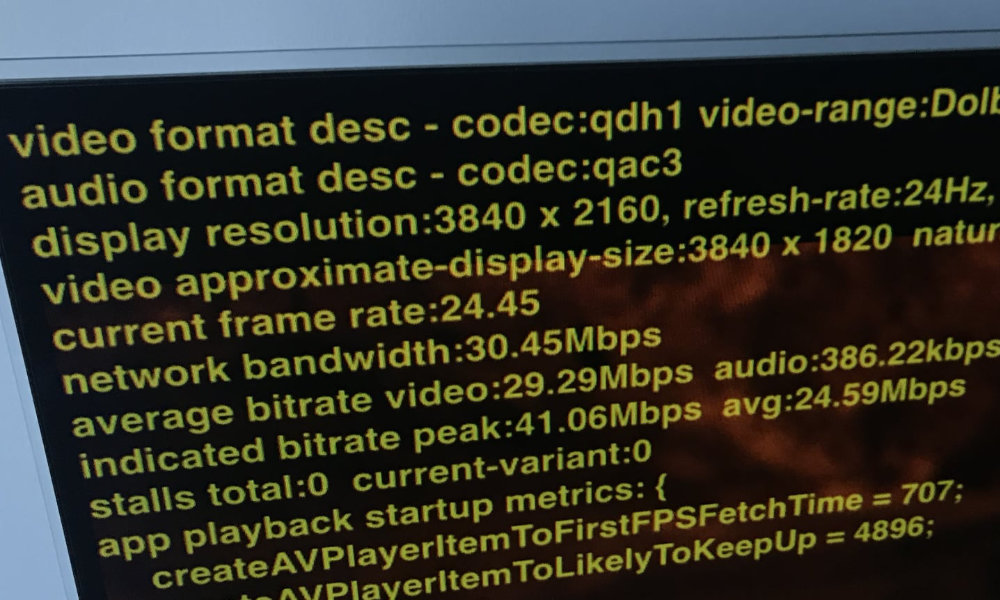Apple TV+ Has the Highest Streaming Video Quality Ever, But You May Want to Watch Your Data Caps

Toggle Dark Mode
One thing that’s easy to miss in Apple’s promotion of all of its new Apple TV+ content is the fact that it’s also offering it all in the highest qualities currently available — 4K Ultra HD HDR video and Dolby Atmos sound.
While a lot of streaming providers have begun to make content available in these 4K resolutions — even Apple has been doing it for a couple of years now with iTunes Movies — it seems that when it comes to Apple TV+, it’s actually pulled out all of the stops, streaming its shows at bitrates never before seen on anything short of physical UHD Blu-ray discs.
According to Rasmus Larsen, founder of Flatpanels HD, Apple is sending its Apple TV+ content over the wire in the highest streaming quality that’s yet been seen for 4K content — well beyond what it even offers for movies sold on its own iTunes Store.
Over the weekend, Larsen conducted the first of a series of measurements that he plans to continue performing over the next few days, discovering impressive results for Apple’s streaming content, with some shows reaching peak bitrates of 41Mbps.
As Larsen notes, Apple TV+ does use variable bitrates, since not all parts of even a single episode require the maximum bitrates, and this has complicated testing since shows have to run for a while in order to calculate a true average bitrate.
Of all of Apple’s new shows, See had the highest bitrate, averaging 29Mbps and peaking at 41Mbps, although his measuring tool wasn’t able to determine how often it hits that peak, since only the overall peak is reported. By comparison, he found that The Elephant Queen averaged around 26Mbps, and Dickinson came in at a lower rate of 17.9Mbps. On the other hand, Snoopy in Space streamed at almost 14Mbps on average, which was particularly impressive since it’s a 2D cartoon that includes basic colours and far less detail than Apple’s live-action shows.
By comparison, a UHD Blu-ray disc normally uses bitrates ranging from 82Mbps to 128Mbps, depending on format and content. Standard HD (not 4K) Blu-ray discs, however, use about half that bitrate. On the other hand, Netflix caps out its 4K bitrate at around 16Mbps, so Apple TV+ content should end up looking much better.
Larsen notes that he didn’t have a Dolby Atmos system connected to his TV, so he was unable to measure the highest audio bitrate.
What’s a Bitrate?
Put simply, the bitrate refers to how much data is used for each second of a video, and naturally the more data is sent out, the higher the quality of the video will be.
It shouldn’t be a surprise that digital images and videos can get pretty big, and over the years ago a number of compression techniques have been invented and refined to reduce the size of pictures and videos while retaining as much quality as possible. To put this in perspective, without compression a single minute of 4K video would take up over 100GB of storage, and require a bitrate of 14Gbps to stream over the internet.
By comparison, a 66GB dual-layer UHD Blu-ray disc can easily hold a two-hour movie, so it’s obvious how magical digital compression is.
Uncompressed video is massive in size, however, because every single frame has to be rendered in its full resolution, even if nothing has changed from frame to frame. With 60 frames stored in each second of HD video, that’s a lot of images. However, among other things, modern compression techniques analyze the differences between each frame, only storing the data that’s necessary to put together the changes. This results in a lot less data being used to store the video.
For example, if you imagine something a golf tournament you can easily see how there may be long spaces of time during which almost nothing is happening in a scene except for a little white ball moving around. By including only those parts that actually change in each frame, video files can be made considerably smaller.
This is also why some shows — and even sections of shows — require higher bitrates than others. For example, a darker scene in See where the characters are sitting around a fire chatting is going to require less data — and a lower bitrate to transmit that data — than a massive battle scene. Similarly, an animated cartoon like Snoopy in Space requires even less data throughout an entire episode, since most of the backgrounds are static and simple colours.
Why This Matters
Assuming you have a 4K-capable streaming device, like an Apple TV 4K, the first and most obvious thing about this is that you’ll be watching your Apple TV+ shows in the highest quality of any streaming service. In fact, this quality should easily rival even UHD Blu-ray discs — even though these technically offer a higher bitrate, there is a point of diminishing returns at which the naked eye isn’t going to notice much difference, especially on most of the TVs that are available today.
However, there’s a dark side to this as well, and that’s the fact that you’re going to need a heftier internet connection to handle it, and if you’re unlucky enough to still have a data cap on your home internet plan, this could easily blow through it.
Unlike iOS devices, the Apple TV set-top box doesn’t have a “low data mode” that can be used to conserve bandwidth, so you’ll always be using the maximum streaming that your internet connection can support. Even on the iPhone and iPad, the “low data mode” only applies to cellular connections, and Apple’s TV app on those devices already limits data usage over LTE, while also lowering the bitrate to something more appropriate for the much smaller screen.







